Although not a part of the old parish of Nonington the small adjoining parish of Knowlton has had close connections to Nonington over the centuries. Since the 1670’s the Knowlton estate has included Kittington, a manor and estate adjoining Knowlton parish in the north-eastern corner of Nonington.
Knowlton, often written as Knolton in the past but I will use the modern spelling, was once an ecclesiastical and civil parish in its own right. The former was abolished in 1940 and the latter in 1935 and the hamlet is now part of the civil parish of Goodnestone-next-Wingham.
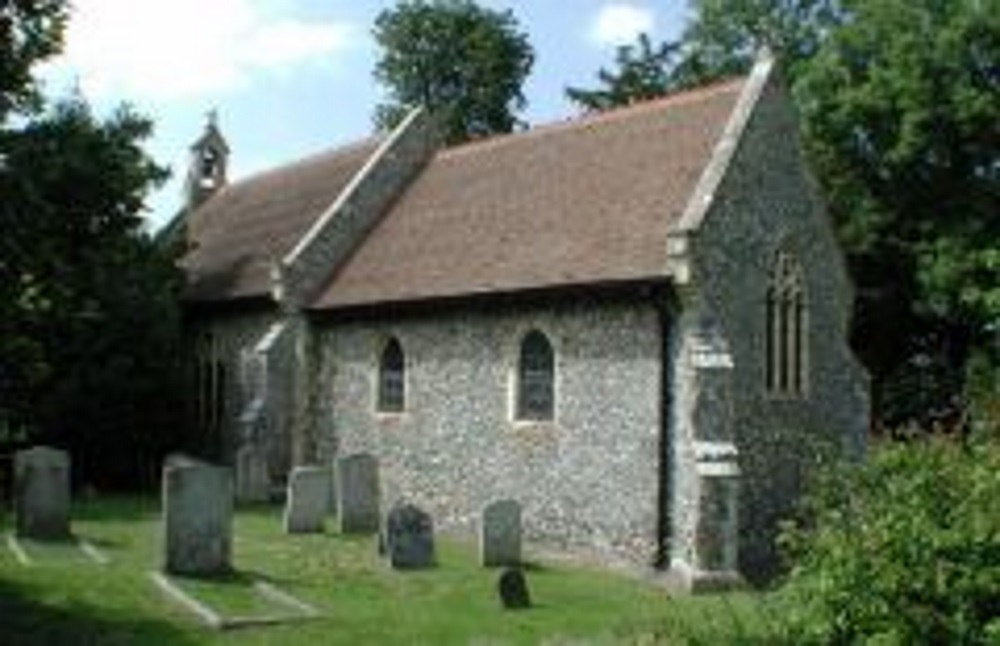
St Clement’s Church adjoins Knowlton Court House but is now redundant and has been in the care of the Churches Conservation Trust since 1st December, 1991. It was originally built as a private chapel for the manor house and later become the parish church. St. Clement’s still contains several fine monuments to the various families that have owned the estate over the centuries. In 1855, the architect William White carried out a restoration replacing the windows, pulpit, box pews and chancel gate.

Around 1800 Knowlton was recorded by Edward Hasted in his history of Kent as extending to some 432 acres, virtually all of which were part of the Knowlton estate. The hamlet consisted of the mansion house and its adjoining building and the parish church and the mansion once had its own cricket ground.
A mile or so east of the mansion was Knowlton Station, a stop on the single track East Kent Light Railway, one of the Colonel Stephens group of cheaply built rural light railways in England, which ran from Shepherdswell Station to Eastry where the railway divided with one line going to Wingham and the other to Richborough. Knowlton station opened on 16th. October, 1916 and closed on 30th October, 1948. The platform was demolished and the track taken up in 1954.
Knowlton was recorded in the Domesday Book of 1086 as Chenoltone, other ancient records referred to it as Cnoltone. The name is said to derive from the Old English cnoll tun: the farmstead by the hillock or knoll. At the time of Domesday it was part of the extensive holdings of Odo, Earl of Kent and Bishop of Bayeaux, a half-brother of William the Conqueror. After Odo’s fall from favour for rebellion the estate, along with many of Odo’s other land holdings was given to members of the de Albineto [also Albini, Albineo, d’Aubigny, and Albinione] family. Knowlton was given to William d’Aubigny, known as ‘Pincerna’, Master Butler of the Royal Household and the adjacent estate of Eswalt, later St. Alban’s Court in Nonington, came into the possession of his younger brother, Nigel.
Cnoltune (Knowlton) later passed into the possession of the Earls of Arundal through Pincerna’s son, William “Strong Hand” d’Aubigny, 1st Earl of Arundal and 1st Earl of Lincoln and then on to the Countess of Eu. The Perot, or Pyrot, family held Knowlton from the Countess by knights service for many years before the estate passed by marriage to William Langley and then his son, also William. Their descendant Edward Langley of Knowlton married Joan Peyton who, after Edward’s death, married Sir Edward Ringley, brother-in-law to William Boys of Fredville in Nonington. After Joan’s death in 1544 Knowlton passed to her brother, Sir Robert Peyton and remained in the Peyton family until after the death in 1684 of his descendant, Sir Thomas Peyton.
Thomas Peyton was born in 1613, the eldest son of Sir Samuel Peyton, the first baronet. He succeeded his father as second baronet on his father’s death in 1623 and inherited Knowlton and other property which gave him an annual income of £1,000 but from the beginning was in financial difficulties, in part due to family commitments. A student of Greek and Hebrew, he disliked the increasing ‘pomposities of the clergy’ under Laud, and in 1640 he stood for Parliament at Sandwich, as had his father, and defeated the Court candidate there. Sir Thomas was a moderate Royalist and withdrew from Westminster in 1643, and was later imprisoned and fined £1,000 by Parliament for disobedience. In 1648 he was one of the leaders of the Kentish Rebellion in the Second English Civil War, and incurred a further fine of £900. Despite this Sir Thomas was active as a director of the Royalist Action Group during the Interregnum and during the intervals between periods of imprisonment devoted himself to Royalist conspiracy and to ‘the business of farming, which notwithstanding will never repair the breaches made in my fortune by the evil of persons and times’. The decimators [collectors or receivers of tithes] then valued his estate at only £540 p.a. Despite his misfortunes he was ‘an excellent husband to two very different wives’.
After the Restoration of King Charles II in 1660 Sir Thomas received some compensation for his losses, receiving some £2,000 per annum from the Newcastle coal tax revenues. He was re-elected to Parliament for the county of Kent in 1661 and during his stay there was involved in some legal proceedings. Sir Thomas died of apoplexy in dire financial straits in February of 1684 and was buried in Westminster Abbey, the baronetcy died with him as he was survived by four daughters and no male heir.

A bird’s eye view of Knowlton Court by Jan Kip showing the house, gardens and the avenues of trees stretching out into the surrounding park. Title along top edge, coat of arms at centre. Published in Dr. Harris’s History of Kent, 1719.
Sir Thomas’s four daughters sold the estate to Sir John Narborough, Admiral of the Royal Navy, who had made a name for himself in the Anglo-Dutch Wars of the 1660’s and 1670’s. Sir John’s two sons, Sir John and James Narborough, were both drowned along with Admiral Sir Cloudesley Shovel when their ship and three others en route home from Toulon foundered during a very bad storm on rocks off the Scilly Isles on 22nd October, 1707 with the loss of over 2,000 sailors lives.
This disaster was caused by the inability of the ships navigators to calculate their longitude with any accuracy and so were unaware of how close they were to the rocks. The losses resulted in the passing of the Longitude Act of 1714, in which the British government offered a reward of £20,000 [present day value around £2.85 million] to who ever invented the first accurate marine chronometer. This was finally achieved after many years work by John Harrison who was rewarded by Parliament in the 1760’s.
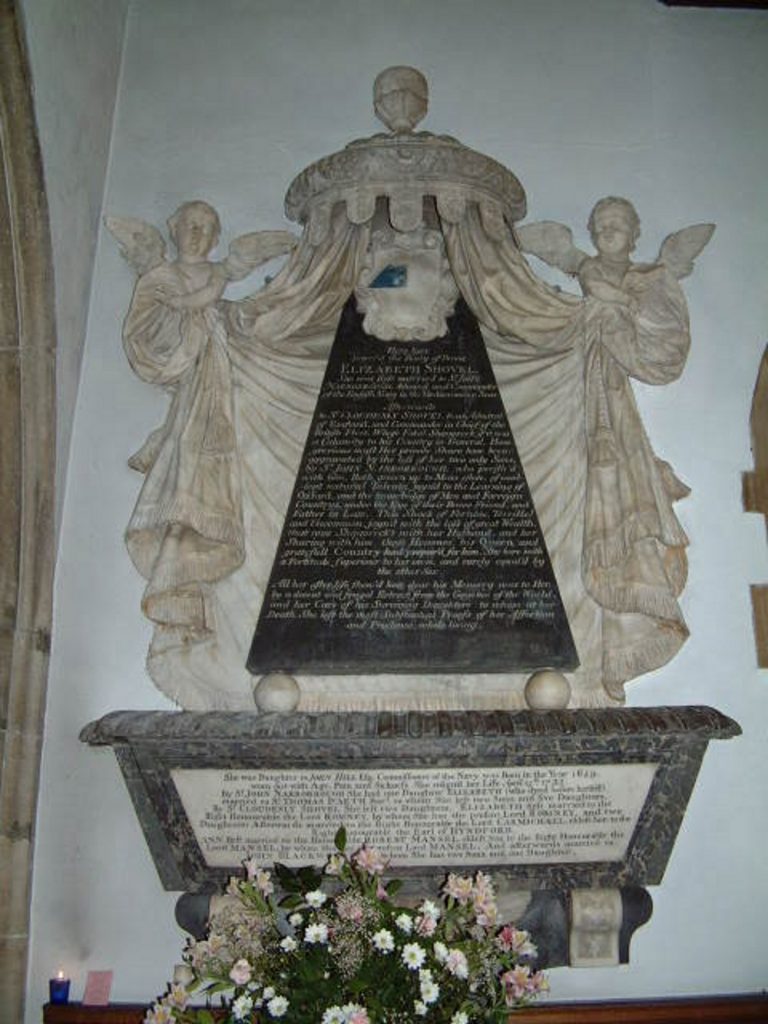
The Narborough brothers both died without heirs and on the death of Sir John Narborough in 1707 the Knowlton Court estate was inherited by Elizabeth D’Aeth, their sister and the first wife of Thomas D’Aeth, esquire of North Cray, Kent, who was elected as the Whig member of Parliament for nearby Sandwich in 1715 and created a baronet by the newly enthroned George I in 1716. Sir Thomas lived at Knowlton and re-built the house originally built by Sir John Peyton in 1585. The D’Aeth crest was “A griffin’s head, or, with a trefoil in his mouth, vert”, and the alehouse in Chillenden which had been called The Dog changed its name to The Griffon’s/Griffin’s Head around 1724.
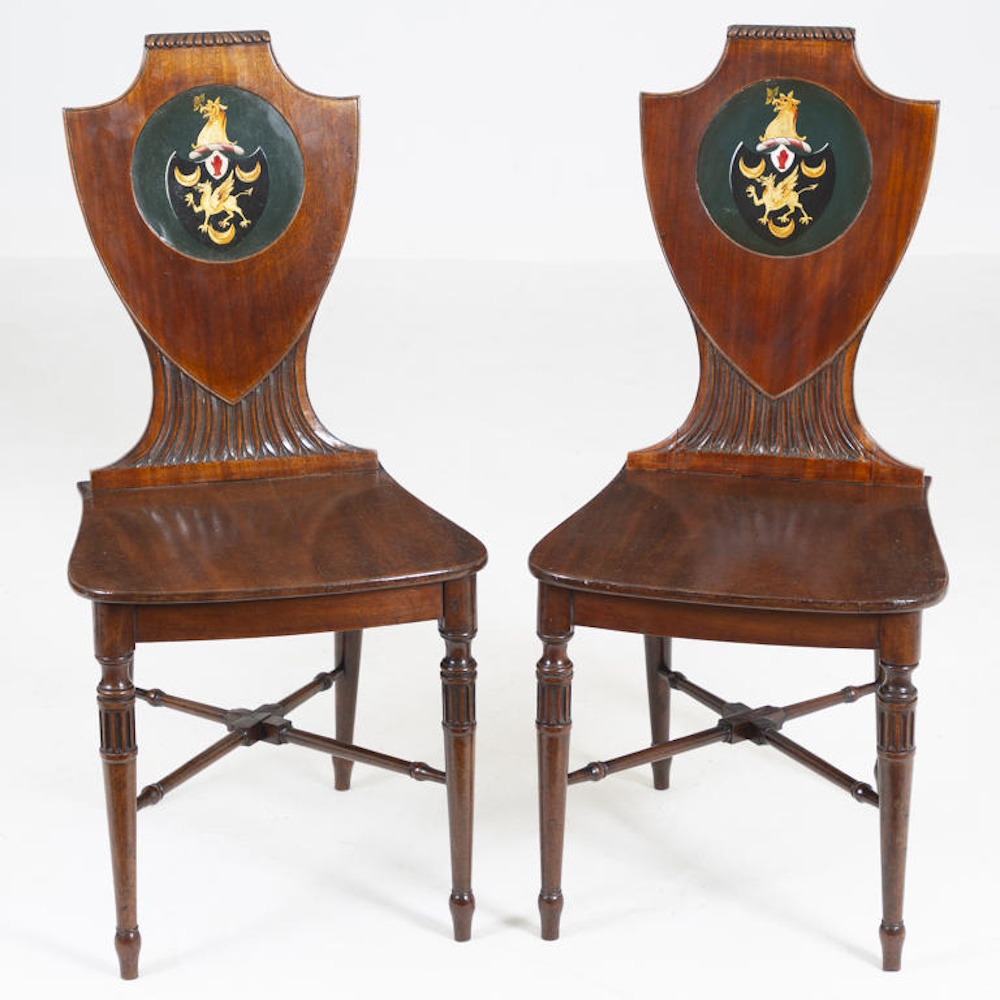
A matching pair of 19th century mahogany shield back hall chairs bearing the arms of D’Aeth of Knowlton Court, Kent, made for Sir Narborough D’Aeth, 3rd baronet of Knowlton.
On the death of Sir Narborough D’Aeth, 3rd baronet, of Knowlton Court on 4th June, 1808, the baronetcy became extinct and the late baronet’s Knowlton estate was inherited by George William Hughes, a distant cousin whose family lived at nearby Bettshanger, and who on inheriting Knowlton added the name D’Aeth to his own. Sir Narborough D’Aeth and George Hughes were both distant descendants of Admiral Sir John Narborough, one of the Commissioners of the Navy in the time of King Charles II.

Knowlton Court from Hasted’s ‘History of Kent’, circa 1778
George Hughes had joined the Navy as a boy of 13 in 1799 and had a successful career, retiring as Admiral George Hughes-D’Aeth in 1846. He was succeeded at Knowlton by his eldest son, Narborough D’Aeth, who in turn was succeeded by his eldest son, Lewis Narborough Hughes D’Aeth.
Lewis was born at Knowlton Court in March 1858. He was commissioned as an ensign in the Kent Militia Artillery in June of 1876 and later transferred with the rank of second lieutenant to the Royal Scots Fusiliers in February of 1879 and was promotion to captain in July of 1887. The following year Captain D’Aeth retired from regular service the following year and took up an appointed with the 3rd Battalion, Royal Fusiliers. The 3rd battalion was a militia battalion, acquired by the regiment under the Childers Reforms of 1881. Lewis D’Aeth resigned his commission from the Royal Fusiliers militia in May of 1898 with the rank of honorary major.
“THE LONDON GAZETTE, MAY 17th 1898
Royal Scots Fusiliers. N. H. D’Aeth resigns his Commission ; also is granted the honorary rank of Major, with permission to wear the prescribed uniform on his retirement. Dated 18th May, 1898”.
Lewis D’Aeth was a keen cricketer and was a prominent figure in Kent cricket. Lewis’s brother Edward and grandfather Henry Knight both also played first-class cricket. In 1894 he made his only first class appearance for the Marylebone Cricket Club (MCC) against Leicestershire at Lord’s. However, he did not distinguish his self at the crease, being twice dismissed for without scoring by Leicestershire bowler George Walton.
In 1904 the now Major Lewis D’Aeth, sold the estate to Francis Elmer Speed, a barrister and stockbroker who also made three appearances for the Marylebone Cricket Club against Kent and Nottinghamshire in 1882 and one appearance in 1884 against Nottinghamshire where he scored a total of 30 runs across the three matches with a highest score of 16. Speed also made minor appearances for Herefordshire. Francis Speed’s first-class cricketing career was slightly more successful than that of Major D’Aeth. Knowlton Court once had its own cricket ground.
Francis Speed was commissioned into the Royal East Kent Yeomanry as a second lieutenant in March of 1900 and served in South Africa in the Second Boer War. He was appointed High Sheriff of Kent in March of 1914, having been unsuccessful in his 1912 and 1913 nominations, and in May of 1914 he was made a temporary major in the Yeomanry and served in the early part of the First World War attached to headquarters before being restored to the Royal East Kent in November of 1916. The temporary majority became a permanent commission in June of 1917 before relinquishing his commission on account of ill health in September 1917. A justice of the peace for Kent, Major Speed died in August of 1928 at Knowlton Court where his descendants still live.
Captain D’Aeth seems to have been in financial difficulties for some time before the sale. My grand-father, Frank Webb, always said that the Knowlton estate changed hands with the turn of a card, so it would appear that Captain D’Aeth was a heavy and not very successful gambler. Whether the change of ownership was in settlement of a debt or to finance the settlement of outstanding debts owed to other creditors is not clear.
In 1895 County Court orders had been taken out against him for the payment of bills for repairs to Knowlton Court house and out-buildings on behalf of the estate of Henry Maxted, a Nonington builder.
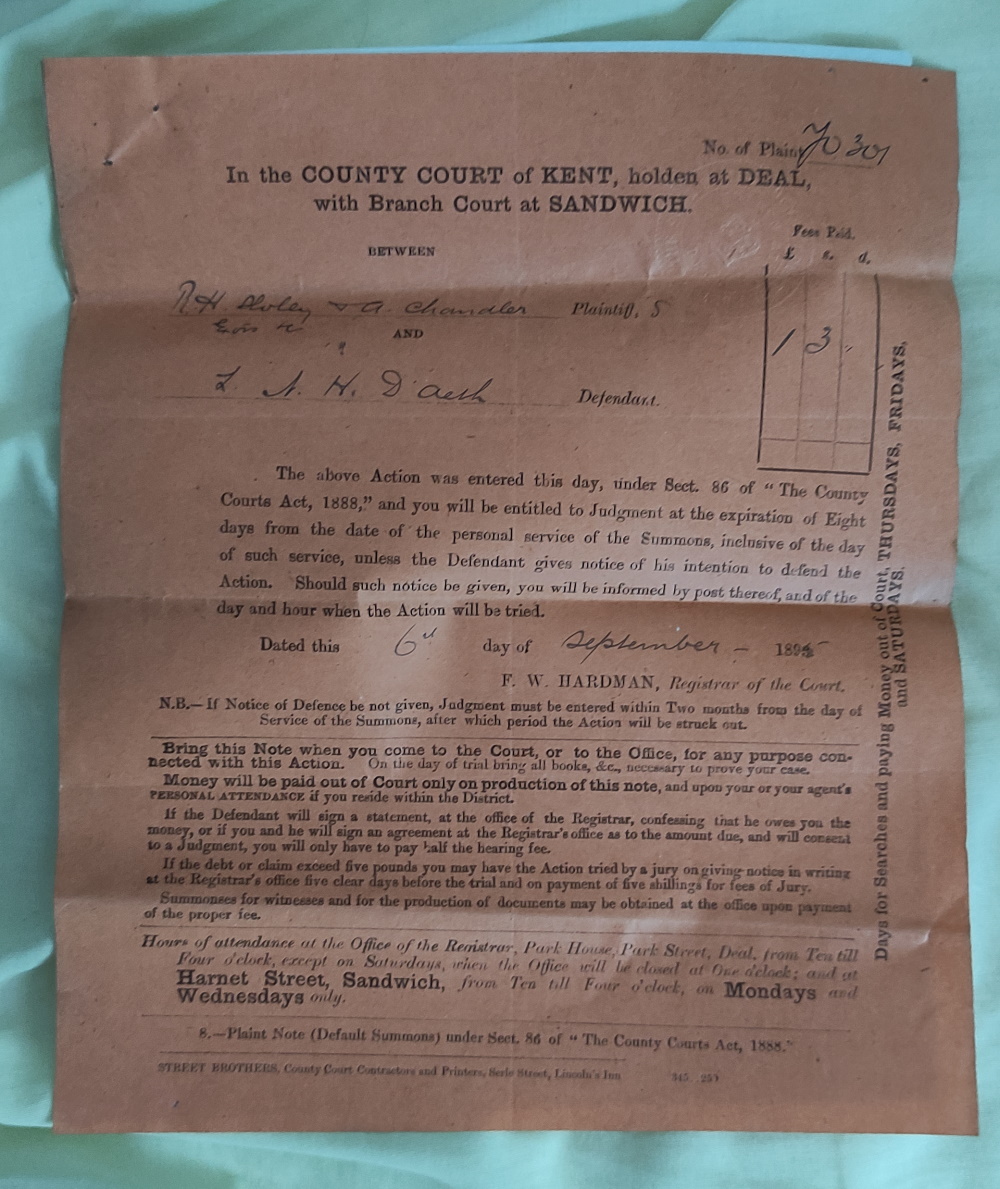
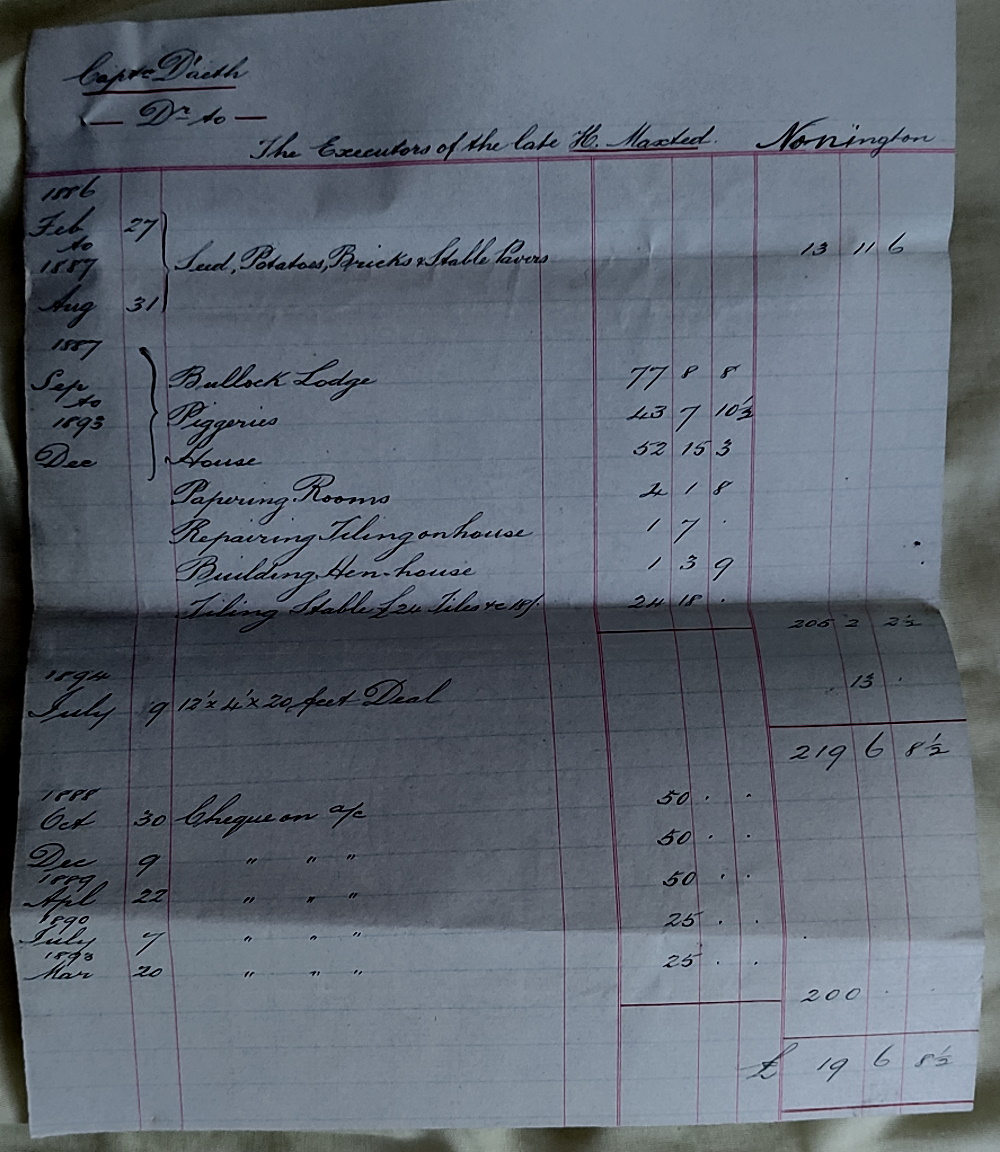
Above left: September, 1895 County Court Judgement in favour of the executors of Mr. Maxted’s estate.
Above right:-The invoice attached to the successful County Court judgement listing the outstanding balance of monies owed for work done at Knowlton Court on behalf of Captain D’Aeth, September, 1895
At the time of the action for debt Captain D’Aeth was serving with the 3rd battalion Royal Scots Fusiliers, at Ayr in Scotland to where letters requesting the settlement of outstanding debts were addressed by Henry Maxted.
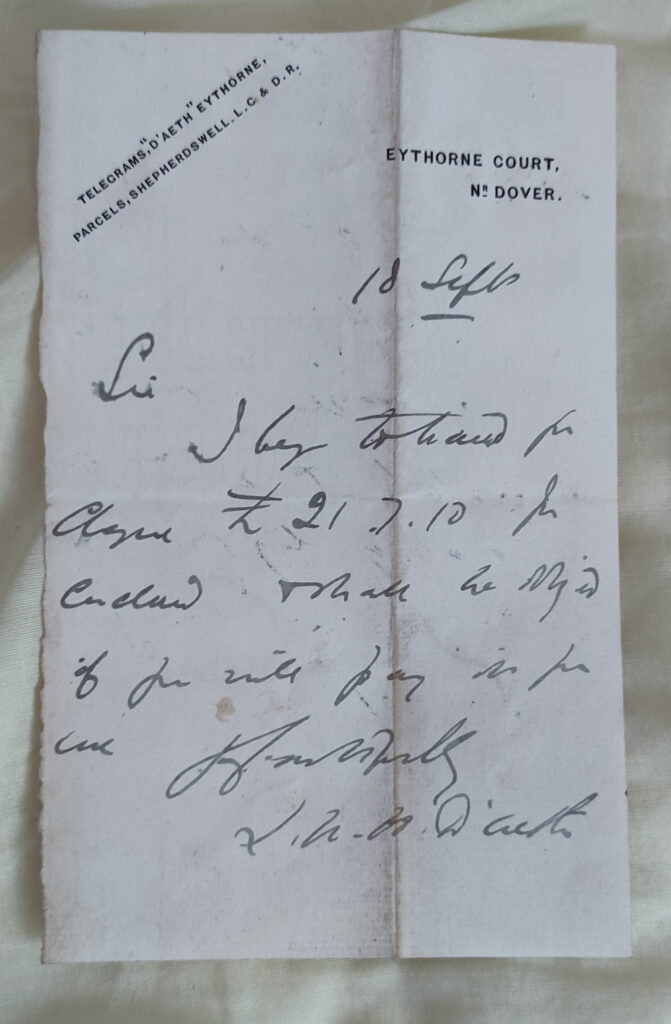
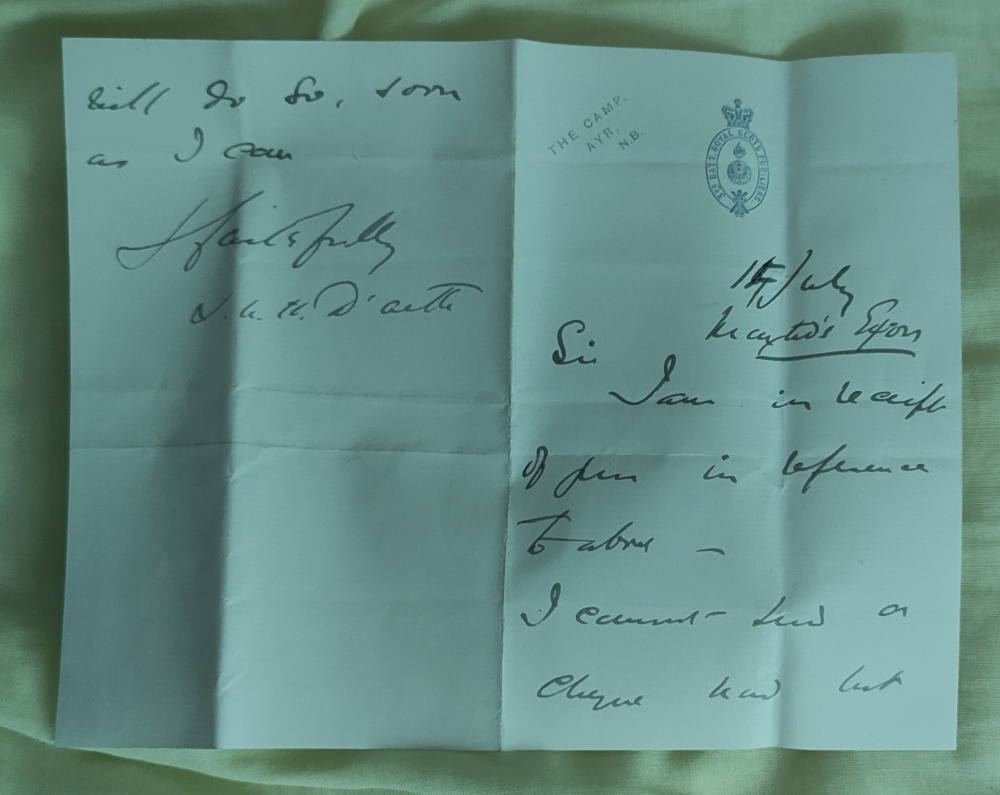
Above left: A “cheques in the post” letter from Eythorne Court to the executors of Mr. Maxted’ estate, 1895
Above right: A “cheques in the post letter” from the Fusiliers regimental camp at Ayr, 1895
During these financially straitened times Lewis appears to have moved from Knolton Court to the nearby Eythorne Court, possibly renting out the much larger Knowlton Court. Later correspondence from creditors was addressed there.
In 1897 ownership of the Griffin’s Head public house in nearby Chillenden had been transferred by the then still Captain D’Aeth to Maj. Gen. Craster Lambert, Lt. Col. Henry Smith and Alexander Browne of Doxford Hall, Chathill, North Humberland (and Callaly Castle, Northumberland). The D’Aeth crest was “A griffin’s head, or, with a trefoil in his mouth, vert”, and the pub had been called The Griffon’s/Griffin’s Head since 1724. Soon after the sale of the Knowlton estate the Griffin was sold to Francis Speed by its co-owners.
It is more than likely that Captain D’Aeth resigned his commission in 1898 because his outstanding debts and the subsequent actions by tradesmen and other creditors, who seem to have included fellow officers amongst their number, for their payment had become an embarrassment to the regiment.
Other parts of the estate were transferred to new owners during this period. In 1898 the owner of Kittington Farm is recorded as being a Major Brown. Once again, the property was sold to Francis Speed soon after he acquired the Knowlton estate.
After the disposal of Knowlton Lewis D’Aeth moved away from the East Kent and died from heart failure at Knewe Lodge in Mark Cross, Sussex in October of 1920.
+++
During the First World War three members of the Speed family and nine men employed on the Knowlton Estate enlisted to fight. This resulted in Knowlton winning of a competition organised in 1914 by “The Weekly Dispatch” to find the “Bravest Village in the United Kingdom”. “The Bravest Village” was defined as a village where the largest proportion of its men volunteered to serve in the armed forces before 28 February, 1915. The driving force behind the men enlisting was Major Francis Speed who had volunteered at the age of 55, and thought that every able bodied man employed on the estate should go. The Reverend Sidney Sargent was also strongly in favour of his parishioners in Nonington and Knowlton volunteering and preached accordingly from the pulpits of the two parish churches. The Reverend Sargent was a man of principle and enlisted along with his parishioners and survived the war.
Getting on for 400 villages competed for the prize of a cross of Aberdeen granite some 17 feet in height with a Roll of Honour cut into the plinth and its column is embellished around the top with the figures of a soldier, a nurse, a casualty, and Victory. The cross was designed by Sir George Frampton.
The then Attorney General, Lord Birkenhead, judged the competition and it was his decision that Knowlton should be awarded the prize. The reasoning behind the award was that twelve men had enlisted from what was said to be a total population of thirty-nine.
However, this was not really true as only the Speed family and their live in servants actually resided in the big house in the hamlet of Knowlton, which was in effect Knowlton Court House and its outbuildings The majority of those who enlisted were only employed on the Knowlton estate and actually lived in the nearby villages of Nonington, Chillenden and Goodnestone. At the time of the award any dissent regarding Knowlton’s eligibility to enter the competition was brushed aside for the sake of national pride and unity, it was a classic example of “why should the truth spoil a good story”, especially at a time in the war when new recruits were needed to replace heavy initial losses.
The cross was unveiled on 1st September, 1919, by Lord Stanhope, and still stands at the side of Sandwich Road near the entrance to Knowlton Court.

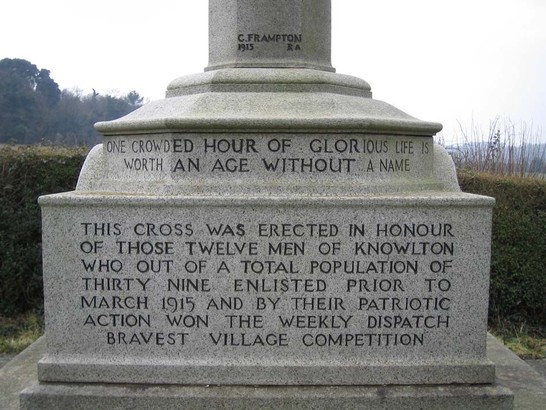
The names inscribed on the monument are:
Major F E Speed, REK Yeomanry
Cpt E I L Speed MC 2nd Life Guards
Cpt D C L Speed 60th Rifles
Cpl C Baldock 4th Buffs
Cpl L Martin MM REK Yeomanry
Ctl C Crocker 2nd Life Guards
Pte W J Brett 6th Buffs
Pte J Lack REK Yeomanry
Pte P O’Brien REK Yeomanry
Pte C Sturdee 4th Buffs
Pte T J Wilkins REK Yeomanry
Pte A Wood 4th Buffs
Major S C H Sargent CF, [vicar of Nonington and Knowlton].
After the unveiling of the cross, erected by W Kirkpatrick of Trafford, Manchester, a number of dignitaries attended celebrations in the grounds of Knowlton Court where tea was taken and music played by the bandsmen of the 5th Lancers. Tea was followed by funfair amusements
The unfortunate Privates Sturdee and Wood were still away on service in India but those named on the memorial who attended were presented with silver cigarette cases and Corporal Martin, who had served with Major Speed in the Royal East Kent Yeomanry, received his Military Cross.
As Knowlton’s men all returned safely service in The Great War the hamlet was also awarded the accolade of a “Thankful Village”, in that it was thankful that all of its men had returned. Only fifty-six villages in England and Wales were to be classified as such, and Knowlton is the only “Thankful Village” in Kent.
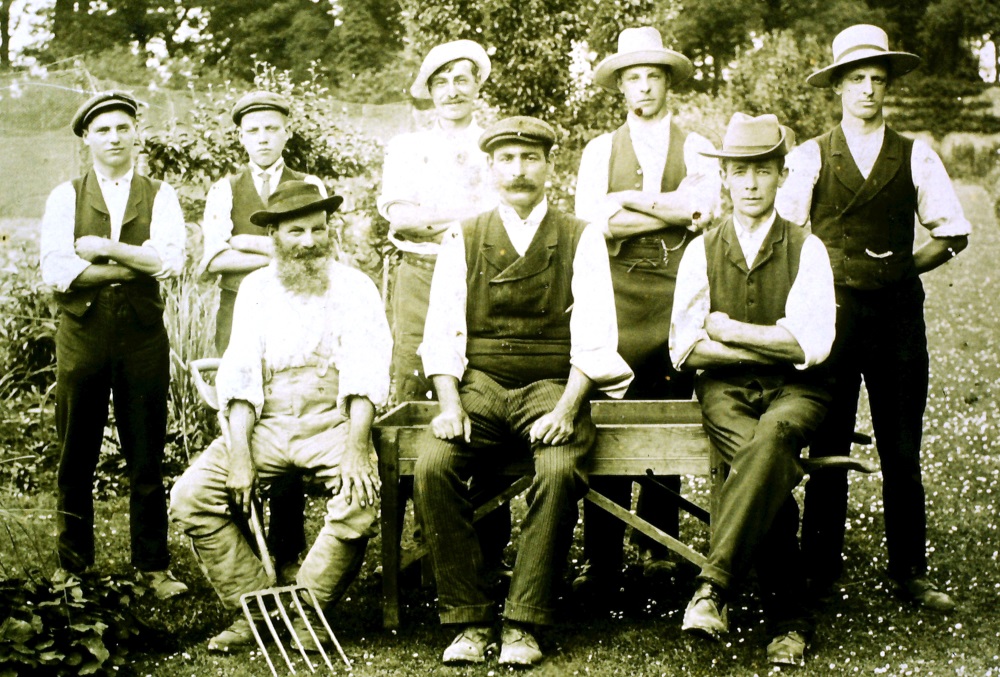
Knowlton Court gardeners just after WW1. The younger men would almost certainly be Knolton’s WW1 veterans. The gardener seated on the right of the front row has the brim of his hat up on the left hand side, an indication that he may have served in the East Kent Yeomanry.
Sadly, the neighbouring parish of Nonington suffered many casualties during “The Great War To End All Wars” and they are remembered, along with those lost in The Second World War, on the memorials at St. Mary’s Church, Nonington.


